S21-002-01
RSP 12656
Grower: Humboldt DNA
General Information
- Accession Date
- July 20, 2022
- Reported Plant Sex
- not reported
- Report Type
- StrainSEEK v3 10Mb
- DNA Extracted From
- Stem
The strain rarity visualization shows how distant the strain is from the other cultivars in the Kannapedia database. The y-axis represents genetic distance, getting farther as you go up. The width of the visualization at any position along the y-axis shows how many strains there are in the database at that genetic distance. So, a common strain will have a more bottom-heavy shape, while uncommon and rare cultivars will have a visualization that is generally shifted towards the top.
Chemical Information
Cannabinoid and terpenoid information provided by the grower.
Cannabinoids
No information provided.
Terpenoids
No information provided.
Genetic Information
- Plant Type
- Type I
File Downloads
The bell curve in the heterozygosity visualization shows the distribution of heterozygosity levels for cannabis cultivars in the Kannapedia database. The green line shows where this particular strain fits within the distribution. Heterozygosity is associated with heterosis (aka hybrid vigor) but also leads to the production of more variable offspring. When plants have two genetically different parents, heterozygosity levels will be higher than if it has been inbred or backcrossed repeatedly.
The ratio of reads mapped to Y-contigs to reads mapped to the whole Cannabis genome (Y-ratios) has been demonstrated to be strongly correlated with plant sex typing. This plot shows the distribution of Y-ratios for all samples in our database which were sequenced with the same method (panel or WGS) as this sample and where this sample falls in the distribution.
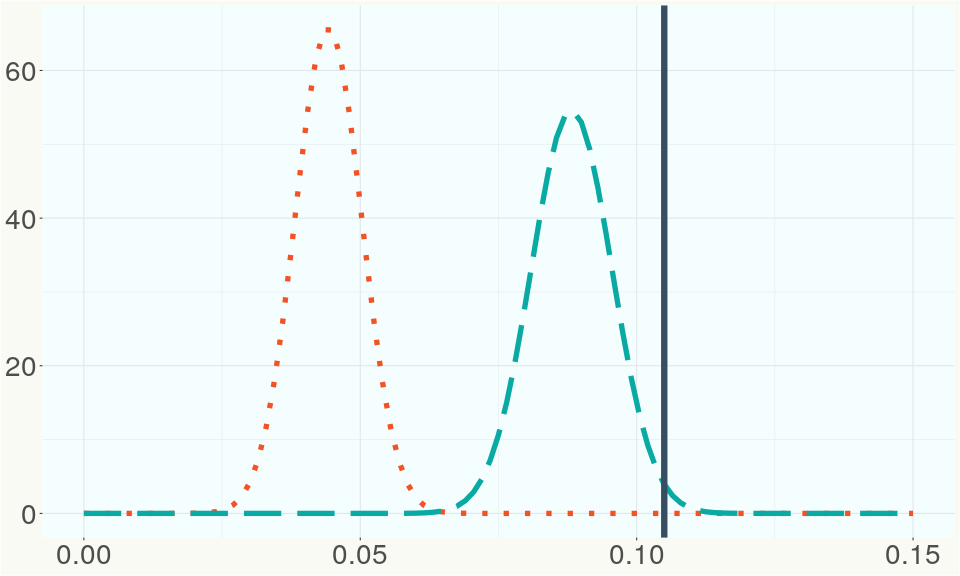
This chart represents the Illumina sequence coverage over the Bt/Bd allele. These are the three regions in the cannabis genome that impact THCA, CBDA, CBGA production. Coverage over the Active CBDAS gene is highly correlated with Type II and Type III plants as described by Etienne de Meijer. Coverage over the THCA gene is highly correlated with Type I and Type II plants but is anti-correlated with Type III plants. Type I plants require coverage over the inactive CBDA loci and no coverage over the Active CBDA gene. Lack of coverage over the Active CBDA and Active THCA allele are presumed to be Type IV plants (CBGA dominant). While deletions of entire THCAS and CBDAS genes are the most common Bt:Bd alleles observed, it is possible to have plants with these genes where functional expression of the enzyme is disrupted by deactivating point mutations (Kojoma et al. 2006).
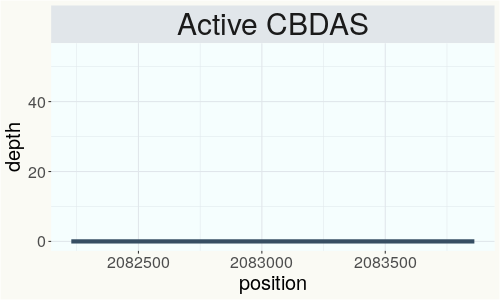
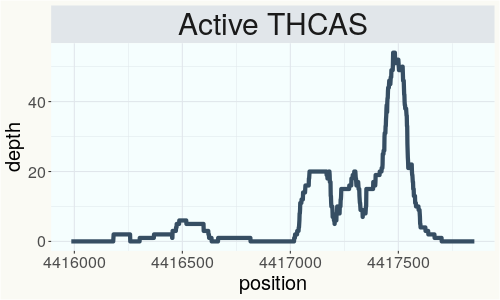
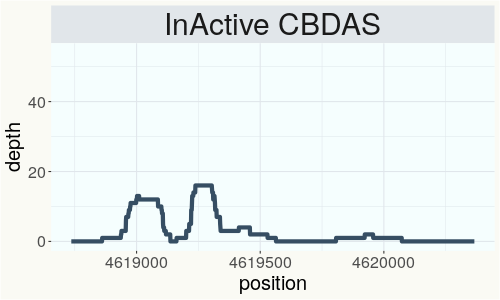
This chart represents the Illumina sequence coverage over the CBCA synthase gene.
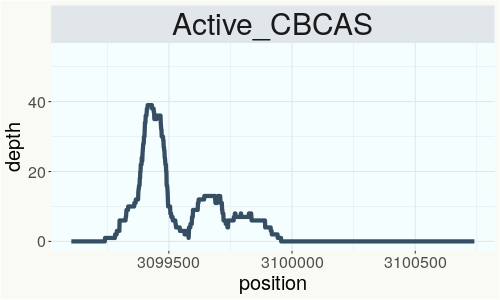
Variants (THCAS, CBDAS, and CBCAS)
Variants (Select Genes of Interest)
| PHL-2 | c.2933G>T | p.Arg978Leu | missense variant | moderate | contig2621 | 342976 | G/T | |
| PHL-2 | c.2936T>G | p.Val979Gly | missense variant | moderate | contig2621 | 342979 | T/G |
|
| PHL-2 | c.3209A>G | p.Gln1070Arg | missense variant | moderate | contig2621 | 343252 | A/G | |
| PHL-2 | c.3467A>G | p.Gln1156Arg | missense variant | moderate | contig2621 | 343510 | A/G | |
| PKSG-4a | c.617A>G | p.Tyr206Cys | missense variant | moderate | contig700 | 1938028 | A/G |
|
| PKSG-4a |
c.626_628del |
p.Asn209del | disruptive inframe deletion | moderate | contig700 | 1938032 | CAAT/C |
|
| PKSG-4b | c.489delT | p.Phe163fs | frameshift variant | high | contig700 | 2721183 | CA/C | |
| FAD2-2 | c.161T>A | p.Leu54His | missense variant | moderate | contig83 | 1803208 | A/T |
|
| FAD2-2 | c.64G>T | p.Ala22Ser | missense variant | moderate | contig83 | 1803305 | C/A |
|
| ELF3 | c.358G>A | p.Gly120Arg | missense variant | moderate | contig97 | 242064 | G/A | |
| ELF3 | c.752G>T | p.Gly251Val | missense variant | moderate | contig97 | 242458 | G/T | |
| ELF3 | c.772A>G | p.Ser258Gly | missense variant | moderate | contig97 | 242478 | A/G |
|
| ELF3 | c.812G>C | p.Gly271Ala | missense variant | moderate | contig97 | 242518 | G/C | |
| ELF3 | c.1630A>G | p.Thr544Ala | missense variant | moderate | contig97 | 244461 | A/G | |
| ELF3 |
c.1803_1805d |
p.His601del | disruptive inframe deletion | moderate | contig97 | 244625 | ACAT/A |
|
| ELF3 | c.1966C>G | p.Pro656Ala | missense variant | moderate | contig97 | 244797 | C/G | |
| ELF3 | c.2141C>G | p.Pro714Arg | missense variant | moderate | contig97 | 244972 | C/G | |
| HDS-2 |
c.82_93delGT |
p.Val28_Thr3 |
conservative inframe deletion | moderate | contig95 | 1989748 |
CGTAACCGGAAC |
|
| HDS-2 | c.127T>G | p.Ser43Ala | missense variant | moderate | contig95 | 1989794 | T/G |
|
| PHL-1 | c.2623A>G | p.Thr875Ala | missense variant | moderate | contig1439 | 1487174 | T/C |
|
| PHL-1 | c.1387A>G | p.Thr463Ala | missense variant | moderate | contig1439 | 1489811 | T/C | |
| PIE1-2 | c.1289A>G | p.Asp430Gly | missense variant | moderate | contig1460 | 1192109 | T/C |
|
| FLD | c.2981T>C | p.Met994Thr | missense variant | moderate | contig1450 | 2044012 | A/G | |
| FLD | c.2964C>A | p.Asp988Glu | missense variant | moderate | contig1450 | 2044029 | G/T | |
| FLD | c.125G>A | p.Ser42Asn | missense variant | moderate | contig1450 | 2047909 | C/T | |
| PIE1-1 | c.1222C>G | p.Gln408Glu | missense variant | moderate | contig1225 | 2281482 | C/G | |
| PIE1-1 | c.6725C>T | p.Ala2242Val | missense variant | moderate | contig1225 | 2289290 | C/T | |
| GGR | c.456T>A | p.His152Gln | missense variant | moderate | contig2282 | 549448 | T/A |
|
| GGR | c.460G>A | p.Asp154Asn | missense variant | moderate | contig2282 | 549452 | G/A |
|
Nearest genetic relatives (All Samples)
- 0.195 A15 (RSP12655)
- 0.198 A13 (RSP12654)
- 0.213 SHERBERT (RSP11355)
- 0.220 Lemon OG Haze (RSP11977)
- 0.229 RKM-2018-021 (RSP11113)
- 0.229 RKM-2018-032 (RSP11124)
- 0.231 RKM-2018-017 (RSP11109)
- 0.236 Skywalker OG (RSP10837)
- 0.239 Thank You Jerry (RSP11459)
- 0.243 Tahoe OG (RSP11189)
- 0.243 SFVxTK (RSP11072)
- 0.243 GG4 (RSP12096)
- 0.245 C Temple (RSP11643)
- 0.249 GG 4 (RSP11461)
- 0.252 501st OG (RSP11241)
- 0.252 RKM-2018-026 (RSP11118)
- 0.253 NSPM1 (RSP11362)
- 0.254 GG4 (RSP11978)
- 0.254 Super Sour Diesel (RSP11191)
- 0.255 Old Family Purple (RSP12098)
Most genetically distant strains (All Samples)
- 0.500 Cherry Blossom (RSP11323)
- 0.488 Unknown- Cherry Wine - 003 (RSP11270)
- 0.488 Cherry Blossom (RSP11328)
- 0.485 Cherry Blossom (RSP11298)
- 0.482 Unknown- Cherry Wine - 001 (RSP11268)
- 0.475 Cherry Blossom (RSP11311)
- 0.467 Cherry Blossom (RSP11334)
- 0.462 Unknown- Cherry Wine - 002 (RSP11269)
- 0.456 Cherry Blossom (RSP11309)
- 0.453 Cherry Blossom (RSP11312)
- 0.452 Cherry Blossom (RSP11318)
- 0.451 Northern Skunk (RSP11456)
- 0.447 Cherry Blossom (RSP11317)
- 0.445 Cherry Fog XL (RSP11458)
- 0.442 Tanao Sri 46 (RSP11486)
- 0.439 Unknown- Cherry Wine - 004 (RSP11271)
- 0.437 JL 3rd Gen Father (RSP11196)
- 0.437 Avidekel (RSP10938)
- 0.433 IUP3 (SRR14708256)
- 0.431 Northern Lights (RSP11501)
Nearest genetic relative in Phylos dataset
- Overlapping SNPs:
- 39
- Concordance:
- 29
Nearest genetic relative in Lynch dataset
- Overlapping SNPs:
- 6
- Concordance:
- 6
Blockchain Registration Information
- Transaction ID
-
369801626749c64e
453e9aad61e13ada 8fd6e158dd09c611 af376248938842c0 - Stamping Certificate
- Download PDF (39.5 KB)
- SHASUM Hash
-
30dae169019171c3df88ecf37d4b2589 535d21c4143886b6 7397e2daa142fa9a